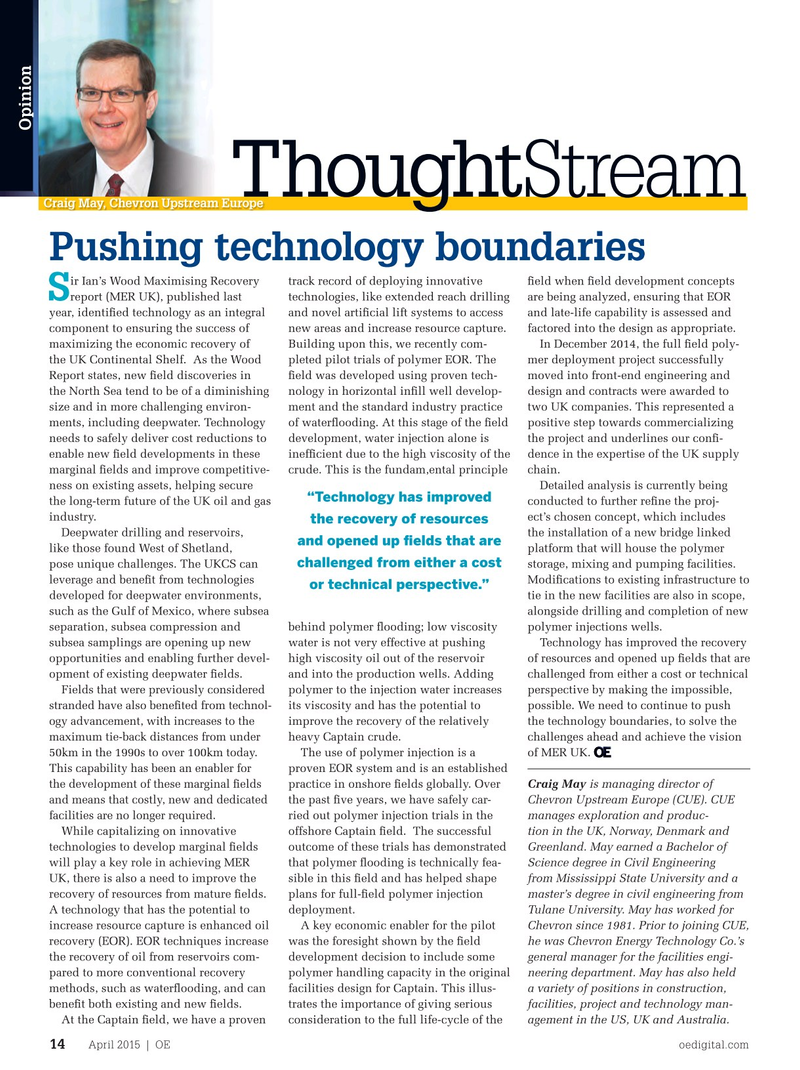
Page 12: of Offshore Engineer Magazine (Apr/May 2015)
Read this page in Pdf, Flash or Html5 edition of Apr/May 2015 Offshore Engineer Magazine
Opinion
Thought Thought ThoughtStream Craig May, Chevron Upstream Europe
Pushing technology boundaries ir Ian’s Wood Maximising Recovery track record of deploying innovative ? eld when ? eld development concepts
S report (MER UK), published last technologies, like extended reach drilling are being analyzed, ensuring that EOR year , identi? ed technology as an integral and novel arti? cial lift systems to access and late-life capability is assessed and component to ensuring the success of new areas and increase resource capture. factored into the design as appropriate. maximizing the economic recovery of Building upon this, we recently com- In December 2014, the full ? eld poly- the UK Continental Shelf. As the Wood pleted pilot trials of polymer EOR. The mer deployment project successfully
Report states, new ? eld discoveries in ? eld was developed using proven tech- moved into front-end engineering and the North Sea tend to be of a diminishing nology in horizontal in? ll well develop- design and contracts were awarded to size and in more challenging environ- ment and the standard industry practice two UK companies. This represented a ments, including deepwater. Technology of water? ooding. At this stage of the ? eld positive step towards commercializing needs to safely deliver cost reductions to development, water injection alone is the project and underlines our con? - enable new ? eld developments in these inef? cient due to the high viscosity of the dence in the expertise of the UK supply marginal ? elds and improve competitive- crude. This is the fundam,ental principle chain.
ness on existing assets, helping secure Detailed analysis is currently being “Technology has improved the long-term future of the UK oil and gas conducted to further re? ne the proj- industry. ect’s chosen concept, which includes the recovery of resources
Deepwater drilling and reservoirs, the installation of a new bridge linked and opened up ? elds that are like those found West of Shetland, platform that will house the polymer challenged from either a cost pose unique challenges. The UKCS can storage, mixing and pumping facilities. leverage and bene? t from technologies Modi? cations to existing infrastructure to or technical perspective.” developed for deepwater environments, tie in the new facilities are also in scope, such as the Gulf of Mexico, where subsea alongside drilling and completion of new separation, subsea compression and behind polymer ? ooding; low viscosity polymer injections wells.
subsea samplings are opening up new water is not very effective at pushing Technology has improved the recovery opportunities and enabling further devel- high viscosity oil out of the reservoir of resources and opened up ? elds that are opment of existing deepwater ? elds. and into the production wells. Adding challenged from either a cost or technical
Fields that were previously considered polymer to the injection water increases perspective by making the impossible, stranded have also bene? ted from technol- its viscosity and has the potential to possible. We need to continue to push ogy advancement, with increases to the improve the recovery of the relatively the technology boundaries, to solve the maximum tie-back distances from under heavy Captain crude. challenges ahead and achieve the vision 50km in the 1990s to over 100km today.
The use of polymer injection is a of MER UK.
This capability has been an enabler for proven EOR system and is an established the development of these marginal ? elds practice in onshore ? elds globally. Over Craig May is managing director of and means that costly, new and dedicated the past ? ve years, we have safely car- Chevron Upstream Europe (CUE). CUE facilities are no longer required.
ried out polymer injection trials in the manages exploration and produc-
While capitalizing on innovative offshore Captain ? eld. The successful tion in the UK, Norway, Denmark and technologies to develop marginal ? elds outcome of these trials has demonstrated Greenland. May earned a Bachelor of will play a key role in achieving MER that polymer ? ooding is technically fea- Science degree in Civil Engineering
UK, there is also a need to improve the sible in this ? eld and has helped shape from Mississippi State University and a recovery of resources from mature ? elds. plans for full-? eld polymer injection master’s degree in civil engineering from
A technology that has the potential to deployment. Tulane University.

 11
11

 13
13